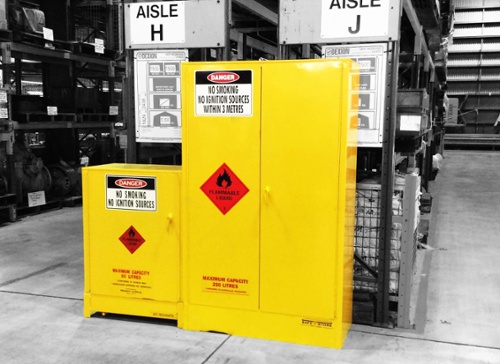When hazardous chemicals are used in the workplace, it’s very important that you store and handle them in a safe and compliant manner. Safe storage of hazardous chemicals is an essential control to mitigate the risks of workplace incidents. In this post, we’ll explain the chemical storage requirements for indoors, so you can store hazardous chemicals in a compliant way that reduces risk.
Hazardous Chemicals
Hazardous chemicals are substances, mixtures or articles that have the potential to cause harm to people, property and the environment.
Under the Globally Harmonised System of classification and labelling of chemicals, there are 29 different classes of hazardous chemicals. These different classifications fall under three main chemical hazards.
These chemical hazards include:
- Physical hazards
- Health hazards
- Environmental hazards
The GHS is a harmonised system for hazard classification criteria and chemical hazard communication. However, the GHS doesn’t outline the requirements for the safe storage of hazardous chemicals.
The requirements for storing hazardous chemicals are detailed in the relevant Australian Standard.
REMEMBER: The Australian Standards are based on the Australian Dangerous Goods Code. Most substances that are classified as dangerous goods are also classified as hazardous substances under the GHS.
Requirements of a Good Chemical Store
Therefore, when you are seeking to safely store hazardous substances classified under the GHS, you must find the corresponding classification in the ADG code.
Once you have found the corresponding dangerous goods classification, you must then find the relevant Australian Standard that outlines the storage requirements for the dangerous substances that you are seeking to store.

Refer to the Australian Standard that applies to your stores of hazardous chemicals.
The Australian Standards outline different storage requirements for each dangerous goods class. However, there are similar chemical storage requirements that are applicable to various dangerous goods classes. While the Standards allow a variety of indoor chemical storage facilities, such as custom-made chemical storage rooms, we’ll be focusing on chemical storage in cabinets — and the requirements that apply to these storage products.
Indoor Chemical Storage in Cabinets
Storing hazardous chemicals safely in an indoor environment requires the use of compliant storage equipment or custom designed and constructed chemical stores. Due to the affordability and convenience of chemical storage cabinets, organisations often choose this option for indoor chemical storage.
However, to be effective in minimising risk, an indoor chemical storage cabinet must meet the specific construction requirements outlined in the relevant Australian Standard, if it is to properly protect your organisation from the dangers associated with your hazardous chemicals.
Even though the construction requirements for safety cabinets for each dangerous goods class are different, there are some similarities.

There are some general requirements for chemical storage cabinets that can assist in the safe storage of chemicals indoors.
A chemical storage cabinet for flammable liquids, flammable solids, oxidising agents, organic peroxides and toxic substances must have:
- Walls, floor, door and roof that is of a double-walled sheet steel construction which has an air gap of at least 40mm
- Self-closing, close-fitting doors.
- The bottom of the cabinet must form a liquid-tight sump that is at least 150mm deep.
- Any shelves within the cabinet must be perforated to allow for free air movement.
Like to learn more about cabinet requirements?
Maximum Indoor Storage Quantities of Hazardous Chemicals
To reduce the risk that hazardous chemicals have upon people and property, the Australian Standards limit the quantity of hazardous chemicals that can be stored within indoor chemical storage cabinets.
The maximum quantities for each dangerous goods classification are outlined below:
| Classification | Maximum Capacity (L) |
| Class 3 - Flammable Liquids | 850 |
| Class 4 - Flammable Solids | 250 |
| Division 5.1 - Oxidising Agents | 250 |
| Division 5.2 - Organic Peroxides - Type B | 50 |
| Division 5.2 - Organic Peroxides - Type C, D, E | 100 |
| Division 5.2 - Organic Peroxides - Type F | 100 |
| Division 6.1 - Toxic Substances | 250 |
| Class 8 - Corrosive Substances | 850 |
Marking and Signage
To ensure that all workers are aware of the risks associated with hazardous substances, chemical storage cabinets must be signed appropriately. All hazardous chemical storage cabinets must be marked with the relevant dangerous goods diamond.
Chemical storage cabinets that are designed for the storage of flammable substances such as flammable liquids and flammable solids must also be marked with a sign that states: “No Smoking No Ignition Sources Within 3m”.
Ventilation
The Australian Standards outline different ventilation requirements for each dangerous goods classification.
The indoor chemical storage cabinets that require ventilation include:
- Class 4.1 - Flammable Solids Storage Cabinets
- Division 5.1 - Oxidising Agent Storage Cabinets
- Division 5.2 - Organic Peroxide Storage Cabinets
The Australian Standards do not make it a mandatory requirement to ventilate chemical storage cabinets used for the storage of flammable liquids, toxic substances, and corrosive substances.
However, if you are storing a flammable, toxic or corrosive substance that is listed in the workplace exposure standards, a ventilation system may be required.
The workplace exposure standards identify around 700 hazardous mixtures and substances and their maximum legal airborne concentrations. If your workplace uses hazardous substances that are listed in the workplace exposure standards, you will have to ensure that the vapours coming from these substances are kept at a concentration below the limits outlined in the workplace exposure standards.
If the concentration of the hazardous vapours exceeds the limits outlined in the workplace exposure standards, you will have to install a mechanical ventilation system on your chemical storage cabinets to keep the concentration of the hazardous vapours at a safe level.
Need more info about ventilation?
Understanding the Requirements for Indoor Chemical Storage
To reduce the risk of workplace incidents, it is very important that you store hazardous substances in a safe and compliant manner. While we’ve highlighted several general requirements for hazardous chemical storage, the full requirements for indoor chemical storage are outlined in the relevant Australian Standards.
If you'd like more information on the design requirements for indoor dangerous goods storage cabinets, you can download our FREE eBook by simply clicking on the image below. Our guide will help you determine your indoor chemical storage needs, so you can meet the requirements of the Australian Standards and WHS Regulations.
Joining the team as a Dangerous Goods Storage Consultant, Melissa Hampton became Storemasta's Marketing Manager in late 2021. With extensive knowledge and experience in chemical compliance, Melissa is responsible for leading the Marketing team and helping shape their marketing strategy. In her spare time, you can find Melissa hiking, swimming and enjoying the great outdoors in beautiful north-west Tasmania.
